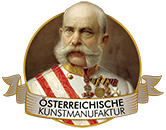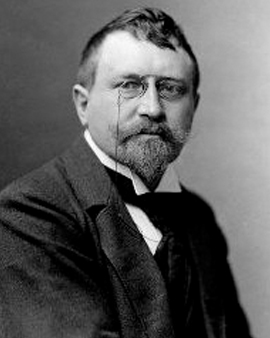Curt Herrmann's upper middle-class background enabled him to make a materially independent decision in favor of his artistic inclinations. As the son of an insurance director, Herrmann experienced German unity and the beginning of the Wilhelmine era directly in Berlin as a youth. Against his father's will, Herrmann left school without a regular degree and tried to gain a foothold in the dynamic artist scene of the German capital. At the age of 19, he enrolled as a student in an artist's studio, which was run by Carl Steffeck. At this time his interest was primarily in people as subjects and especially in portrait painting. The spirit of the times in the new German Empire, its militaristic orientation, the imperial claim to power and the struggle for colonies, left clear traces in the art scene in the 1870s and 1880s. History painting and its inherent pathos celebrated triumphs. Herrmann did not escape this fascination at first, and enrolled as a student of the history painter Lindenschmit at the Munich Academy.
In addition to portrait painting, a passion for depicting and artistic work in nature emerged early on. Herrmann was fascinated by natural colours and light effects. His landscape paintings became the model for a young generation of artists. He himself discovered Neo-Impressionism as a form of expression. With the founding of a drawing school for women of Berlin society, Herrmann established himself in the art scene of Berlin and with his business idea served the artistic educational ideal of the upper middle-class and noble lady of the time. His professional success and his marriage to Sophie Herz, one of his students, put Herrmann in a position to pursue his artistic ambitions with material independence.
With his return to Berlin, Herrmann became an important part of German painting in the Empire, not only as an artist, but above all as a patron and art theorist. As co-founder and member of the board, he contributed to the establishment of modern art in Germany in the Berlin Secession and the Deutscher Künstlerbund. His efforts to achieve a reception of French Neo-Impressionism in Germany led to a collaboration with the gallery owner Paul Cassirer. In 1906 Herrmann organized an exhibition of French artists at the Berlin Secession on his own initiative. In addition, Herrmann was also active as a patron of the artists' association "Die Brücke". He organized exhibitions, established relationships and distinguished himself as an art collector. In the 1920s he not only turned his back on Berlin, but also changed his own painting style significantly. At his mother-in-law's castle, his late passion was devoted to still lifes with flowers, which he partly developed into an almost abstract formal language.
During the National Socialists' Night of Pogroms, some of his paintings were destroyed at Pretzfeld Castle. At the centre of the Nazi attacks was a central work from Herrmann's early years. Because of a boy's act they accused the artist of immoral and homoerotic tendencies.
×





.jpg)
.jpg)
.jpg)
.jpg)
.jpg)
.jpg)
.jpg)
.jpg)
.jpg)
.jpg)
.jpg)
.jpg)
.jpg)
.jpg)
.jpg)
.jpg)
.jpg)
.jpg)
.jpg)
.jpg)
.jpg)
.jpg)
.jpg)
.jpg)
.jpg)
.jpg)
.jpg)
.jpg)
.jpg)
.jpg)
.jpg)
.jpg)
.jpg)
.jpg)
.jpg)
.jpg)
.jpg)
.jpg)
.jpg)
.jpg)
_-_(MeisterDrucke-590581).jpg)
_-_(MeisterDrucke-590581).jpg)
.jpg)
.jpg)
.jpg)
.jpg)
.jpg)
.jpg)
.jpg)
.jpg)
.jpg)
.jpg)
.jpg)
.jpg)
.jpg)
.jpg)
.jpg)
.jpg)
.jpg)
.jpg)
_-_(MeisterDrucke-1128988).jpg)
_-_(MeisterDrucke-1128988).jpg)
.jpg)
.jpg)
.jpg)
.jpg)
.jpg)
.jpg)
.jpg)
.jpg)
.jpg)
.jpg)
.jpg)
.jpg)
.jpg)
.jpg)
.jpg)
.jpg)
.jpg)
.jpg)
.jpg)
.jpg)
.jpg)
.jpg)
.jpg)
.jpg)
.jpg)
.jpg)
.jpg)
.jpg)
.jpg)
.jpg)
.jpg)
.jpg)
.jpg)
.jpg)
.jpg)
.jpg)
_-_(MeisterDrucke-1129967).jpg)
_-_(MeisterDrucke-1129967).jpg)
.jpg)
.jpg)
.jpg)
.jpg)
.jpg)
.jpg)
.jpg)
.jpg)
.jpg)
.jpg)
.jpg)
.jpg)
.jpg)
.jpg)
.jpg)
.jpg)
.jpg)
.jpg)
.jpg)
.jpg)
.jpg)
.jpg)
.jpg)
.jpg)
.jpg)
.jpg)
.jpg)
.jpg)
.jpg)
.jpg)
.jpg)
.jpg)
.jpg)
.jpg)
.jpg)
.jpg)
.jpg)
.jpg)
_-_(MeisterDrucke-590577).jpg)
_-_(MeisterDrucke-590577).jpg)
.jpg)
.jpg)
.jpg)
.jpg)
.jpg)
.jpg)
.jpg)
.jpg)
.jpg)
.jpg)
.jpg)
.jpg)
.jpg)
.jpg)
.jpg)
.jpg)
.jpg)
.jpg)
.jpg)
.jpg)
.jpg)
.jpg)
.jpg)
.jpg)
.jpg)
.jpg)
.jpg)
.jpg)
.jpg)
.jpg)
.jpg)
.jpg)
.jpg)
.jpg)
.jpg)
.jpg)
.jpg)
.jpg)
.jpg)
.jpg)
.jpg)
.jpg)






